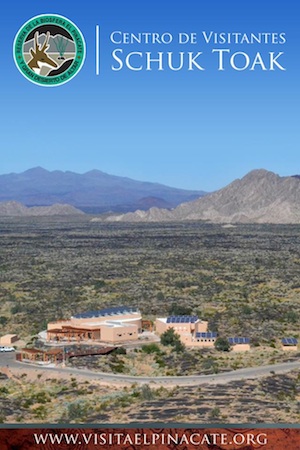Sustainable building inserted into an ecosystem
The ‘Alto Golfo de California‘ biosphere reserve comprises the ‘Pinacate’ area, the ‘Gran Desierto del Altar’ and the ‘Bahía de Adair’ in the Gulf of California’s border, covering an area of 1,652,110 ha. Geological volcanic formations with craters, dunes, oasis and beaches, and the diversity of plants associations determine its special landscape.
One of four fundamental elements of the Biosphere Reserve model it’s the research and promotion of its biological resources, reason why, in a combined effort with the National Commission of Natural Protected Areas (CONANP) and the Tourism Promotion Commission for the State of Sonora (COFETUR), through El Pinacate and Gran Desierto de Altar Biosphere Reserve, negotiated the construction of a space dedicated to the education of conservation, in addition to supporting the development of sustainable tourism in this natural protected area.
The ‘Schuk Toak’ Visitor Centre, Sacred Mountain in Pápago dialect (Tohono O’odham), represents a model of integrated and sustainable intervention in line with the ideas recommended for actions in biosphere reserves.
The Visitor Centre project
Having into consideration as one of the main factors the integration to the local ecosystem and the autonomy of economic resources, the project for the Visitors Center was conceptualized into an autonomous building: “an active system that would be inserted into an ecosystem”; as a consequence of which the concept establishes more in a way of in habitat than just an architectural design with a low energy consumption criteria.
The project it’s constituted by a main axle that favors orientation achieving by bioclimatic design strategies cross ventilation, taking advantage of the sun´s path will naturally illuminate the interior of the building. Concerning the constructive system we choose the one that would have less impact on site: a prefabricated steel structure and autoclaved aerated concrete blocks that allows a clean constructive procedure, these offer a high thermal resistance grade which is why they result a key factor in the design strategy of the building´s skin.
Another premise for the Visitors Centre is the application of “green technologies”, incorporating a PV system as a primary energy source, as well as an absorption chiller, will offer a higher energetic performance coefficient than the traditional system.
Thanks to its PV system, the visitor centre has stopped emitting 149.9 metric tons of CO2 into the atmosphere in its first year, which is equivalent to the environmental service provided by 449 trees.
The design and building process of these facilities are in line with an innovative and responsible vision. The best options and techniques of alternative energies were taken into consideration, as well as efficient use of water, orientation, insolation, prevailing winds, thermal materials, etc., so that the building is self-sufficient in energy and educational. In addition to the facilities, the centre has a Desert Botanical Garden of 30,000 m2.
Lessons learned and replicability
Tourism and education are extremely important activities in biosphere reserves. The facilities that support these activities express what biosphere reserve managers seek to transmit to visitors. Such projects open the possibility to demonstrate, besides the natural value, how it is possible to design a habitat in harmony with the environment using renewable energies.
Visitor centres are the gateways to the biosphere reserves and their perception determines the visitor’s experience. Within this context, centres such as Schuk Toak, bring a new dimension of compromise with responsible and sustainable tourism.
The visitor centre was the first self-sufficient public building in the country. This pioneer role strengthens its capacity for replication in similar areas in Mexico and in other biosphere reserves in desert areas of the world.


















